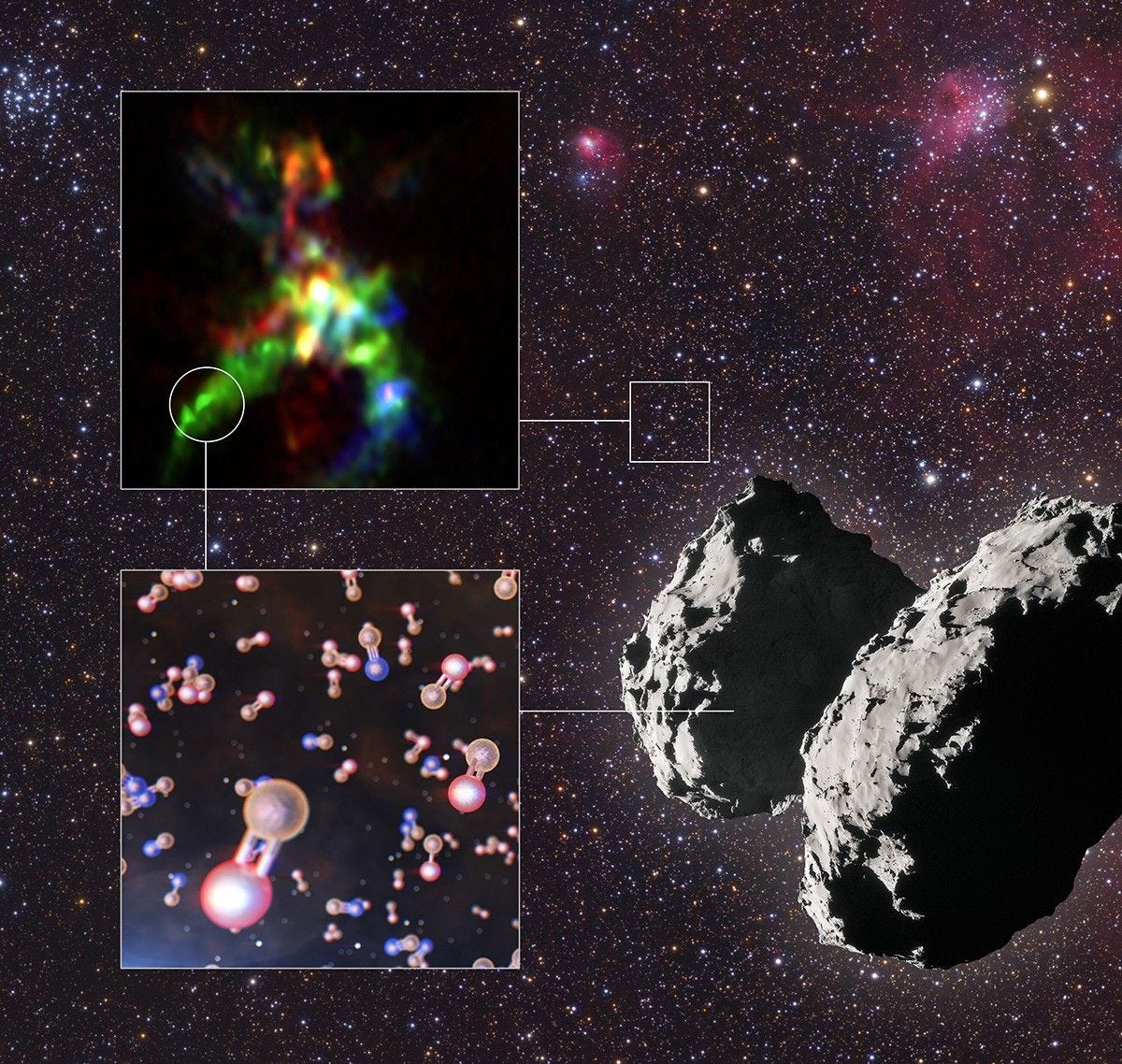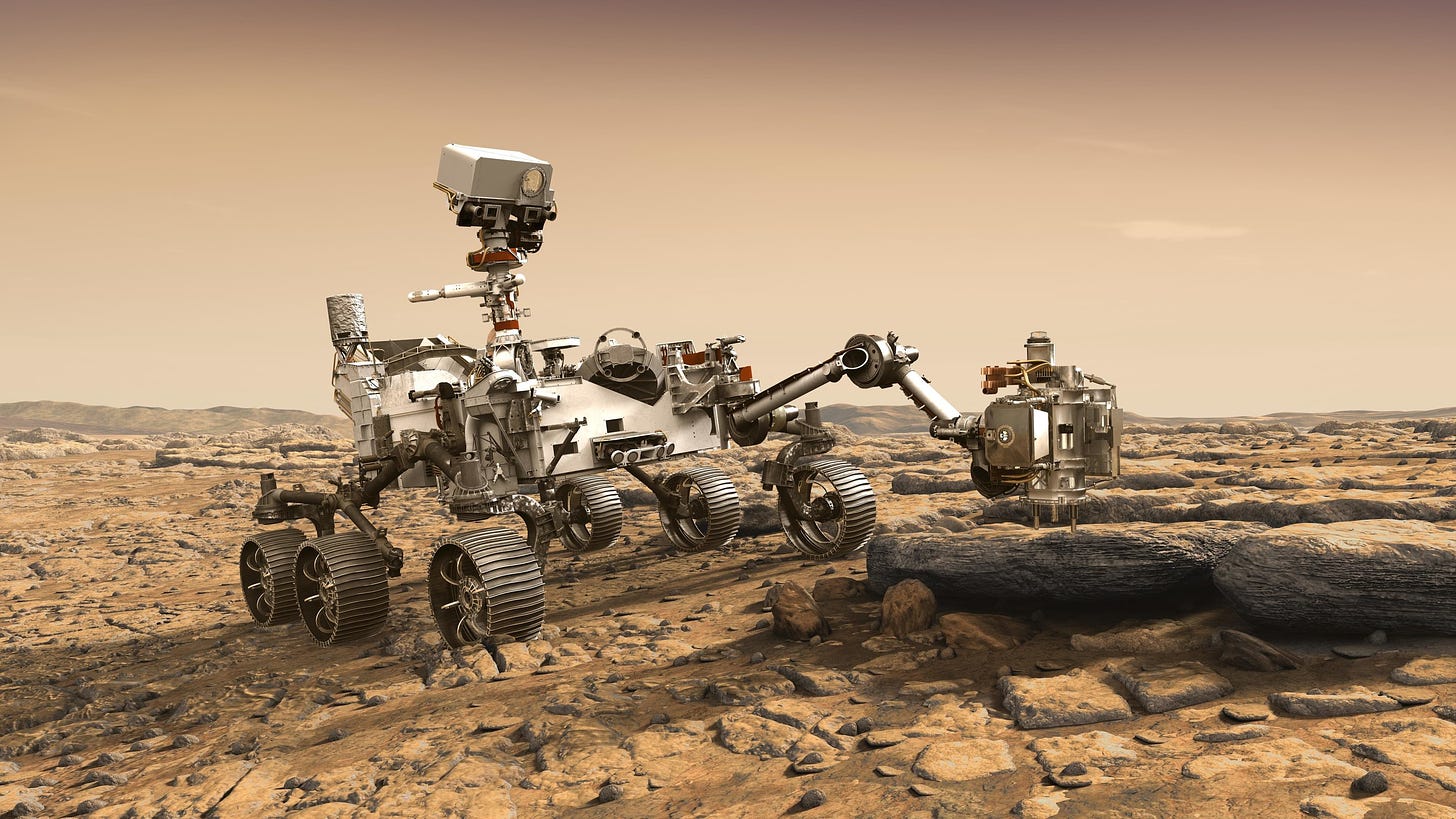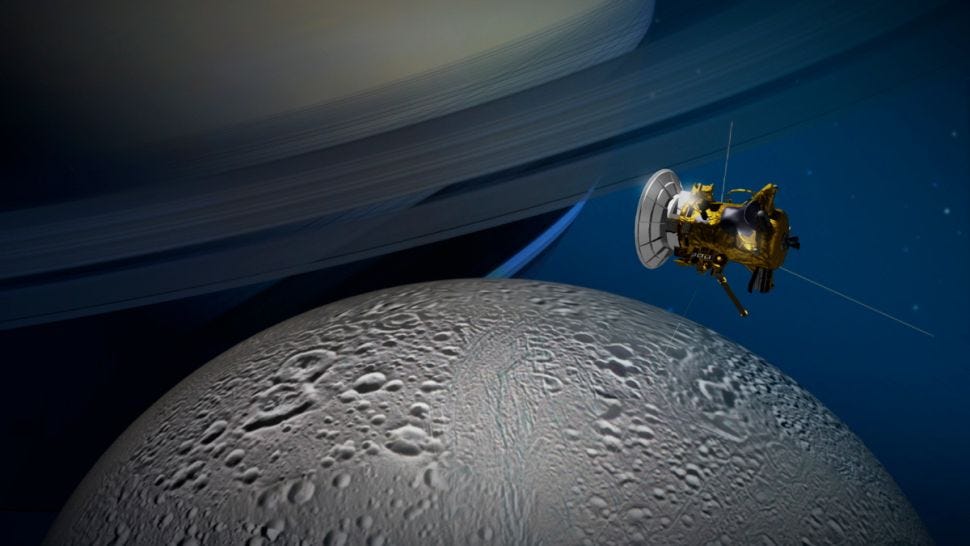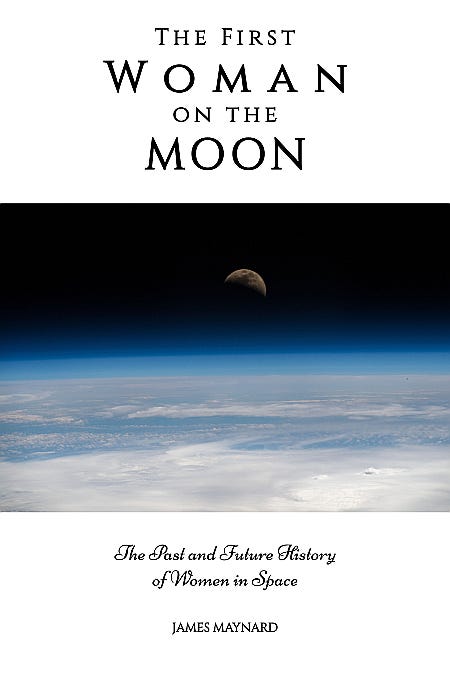The Cosmic Companion January 25, 2020
The building blocks of life on Earth and Enceladus, the salty waterways of ancient Mars, mysterious particles permeate space, and more!
Hello everyone!
New discoveries and findings reveal new findings about the ancient Universe, the origin of life on Earth (and possibly, Mars), and the production of complex chemistry on one of the moons of Saturn.
Listen and subscribe to Astronomy News with The Cosmic Companion through any major podcast provider, including iTunes, Spotify, or TuneIn! Or, listen in at: https://thecosmiccompanion.substack.com.
The Cosmic Companion also offers a premium newsletter, featuring weekly exclusive videos, the astronomy comic of the week, and more. Just $5 a month, or $50 a year! Sign up at: https://thecosmiccompanion.substack.com.
Or, you can buy me a cup of coffee for my work!
Let’s take off!
The Week in Space
Life’s Building Blocks may have been Delivered by Comet
By Rob Lea
Found in DNA and cell membranes, phosphorous is a crucial building block for life. New research suggests that this important element may have been seeded on Earth by comets.

The background of this infographic shows a part of the night sky in the constellation of Auriga, where the star-forming region AFGL 5142 is located. The ALMA image of this object is on the top left of the infographic, and one of the locations where the team found phosphorus-bearing molecules is indicated by a circle. The most common phosphorus-bearing molecule in AFGL 5142 is phosphorus monoxide, represented in orange and red in the diagram on the bottom left. Another molecule found was phosphorus mononitride, represented in orange and blue. Using data from the ROSINA instrument onboard ESA’s Rosetta, astronomers also found phosphorus monoxide on comet 67P/Churyumov–Gerasimenko, shown on the bottom right. © ALMA (ESO/NAOJ/NRAO), Rivilla et al.; ESO/L. Calçada; ESA/Rosetta/NAVCAM; Mario Weigand, www.SkyTrip.de
The question of how phosphorous — an essential building block of life — first became available on Earth 4-billion years ago at the dawn of life has puzzled scientists for decades. Now, astronomers believe they have found the answer, their research suggests that the element — born in star-forming regions of space — was likely deposited on Earth by comets. The researchers also found that the molecule phosphorous monoxide could have played a vital role in the formation of life.
Read more: http://bit.ly/Life-Building-Blocks-Comet
The Salty Waters of Mars
By James Maynard
The ancient waterways of Mars were rich with salt and minerals — was microbial life also part of the alien soup?

An artist’s concept of the Curiosity rover on Mars, drilling into the crust, attempting to understand the material which sits just below the surface. Image credit: NASA
The Curiosity rover on Mars has sampled ancient lake deposits from Gale Crater on the Red Planet, showing water which once existed there was dense with salt and minerals. By studying mineral deposits on Mars, researchers hope to better understand the composition of water on the surface of that world in the ancient past. Water, on Earth or on Mars, leaves distinctive chemical traces, and examination of mineral deposits can reveal significant information about long-lost seas.
Researchers study the salinity of deposits — the concentrations of salt in formations which were once exposed to water. They also look at the redox state of minerals — essentially, the balance between hydrogen and oxygen—in samples to better understand the sample material. Here on Earth, material which is exposed to the atmosphere becomes oxygen-rich, while samples from just a few inches underground show higher concentrations of reducers like hydrogen.
Read more: http://bit.ly/Salty-Waters-Mars
Enceladus has Lovely Plumage — and Complex Chemistry
By James Maynard
The plumes of Enceladus erupt with water — as well as clues to what lies beneath this icy moon of Saturn.

Enceladus is an active moon, erupting with geysers of water ice, sending vast quantities of frozen material into the cold, dark space surrounding Saturn. This body, the sixth-largest moon of Saturn, is also a water world, where vast bodies of liquid water run beneath its frozen surface.
A new geochemical model of Enceladus shows carbon dioxide seen rising form these mighty geysers is likely the product of chemical reactions which occur on the ocean floor of this Saturnian satellite. This suggests a geological and chemical environment far more complex than previously believed, researchers suggest.
Read more: http://bit.ly/Enceladus-Plumage-Chemistry
Did a Massive Asteroid Bring an End to Snowball Earth?
By James Maynard
An ancient glaciation period 2.2 billion years ago may have come to an end when an enormous asteroid collided with Earth, a new study reveals.

The planet has undergone several eras of being a “Snowball Earth,” and one such event could have come to an end 2.2 billion years ago, following an impact between the Earth and a massive asteroid. Image credit: NASA
Snow and ice covered the Earth billions of years ago, forming the Paleoproterozoic snowball Earth. This frigid era, which began as new lifeforms flooded the atmosphere with oxygen, ended as a massive meteor impacted Earth, a new study reveals.
The impact in the frozen tundra that is now Western Australia released hundreds of trillions of kilograms of water vapor into the atmosphere, raising temperatures around the globe, freeing Earth from its frozen existence.
Read more: http://bit.ly/Asteroid-Snowball-Earth
Ancient Star’s Atmosphere Reveals Large Amounts of Oxygen
By Rob Lea
Astronomers have discovered an ancient star has an unusual atmosphere, which just may give us a clue how oxygen became so abundant in the cosmos.

Artistic image of the supernova explosions of the first massive stars that formed in the Milky Way. The star j0815+4729 was formed from the material ejected by these first supernovae. ( Gabriel Pérez, SMM (IAC))
Researchers from institutes across the world including the University of California San Diego, the Instituto de Astrofísica de Canarias (IAC), and the University of Cambridge have examined the atmosphere of a ‘primitive star’ — J0815+4729 located 5k light-years from Earth— discovering an abundance of oxygen. The finding, reported in The Astrophysical Journal Letters, comes as something of a surprise because as one of the first stars to form in the universe, J0815+4729 is one of the oldest and most elementally depleted stars ever recorded by astronomers.
The research conducted with the aid of the W.M Keck Observatory located on Maunakea in Hawaii consists of am analysis of the chemical make-up of the ancient star, providing, in-turn, a clue as to how oxygen and other vital elements were created within the universe’s first generation of stars.
Read more: http://bit.ly/Star-Atmosphere-Oxygen
New News of Neutrinos
By James Maynard
Scientists are learning more about mysterious particles that penetrate everything in the Cosmos but are almost impossible to find. Almost.

A look inside the Borexino Detector, designed to study highly-elusive neutrinos. Image credit: Borexino Collaboration
Neutrinos are often thought of as ghost particles, rarely interacting with anything, making detection of these elusive particles astonishingly difficult. Study of these subatomic particles is, in turn, incredibly challenging.
Researchers at the Borexino collaboration now report recording neutrino interactions 53 times, nearly double the previous record. The detector, located 1,400 meters (4,600 feet) beneath the Gran Sasso massif near Rome, could help unwrap secrets of stars, as well as geological processes taking place deep within the Earth.
Read more: http://bit.ly/New-News-Neutrinos
Read more stories at www.thecosmiccompanion.com

Coming soon: The First Woman on the Moon: The Past and Future History of Women in Space by James Maynard
Thanks for reading!
You can also listen to my new podcast, Astronomy News with The Cosmic Companion, available on all major podcast distributors, including iTunes, Spotify, and TuneIn! Or, tune in at: https://thecosmiccompanion.substack.com. You can also add Astronomy News with The Cosmic Companion to your flash briefings on Amazon Alexa!
If you want to keep up with the latest updates and news about astronomy and space exploration, visit www.thecosmiccompanion.com, join my Facebook page, subscribe on YouTube, and follow @TheCosmicCompanion on Instagram and @CompanionCosmic on Twitter.
Remember - VIP subscribers receive this newsletter, plus a second weekly newsletter with sneak previews of each video episode of Astronomy News with The Cosmic Companion, an astronomy comic of the week, rare space photos, and more! Plans start at just $5!
Do you know someone else who would love this newsletter? Please share! Invest in knowledge with a premium subscription for yourself or a loved one today (including advance viewings of my weekly video show)! Or, I’d love it if you could buy me a cup of coffee - I LOVE coffee!
Thanks for everything and I will see you next week!
Astronomy - Don’t Leave Home Without It!
- James


